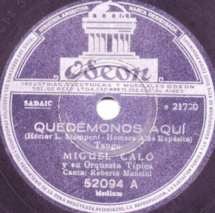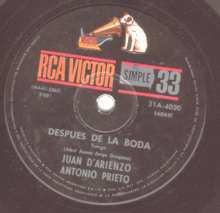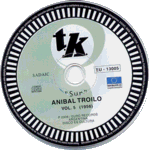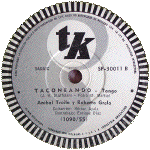



 |
A beginner's guide to tango record labels. |
Ever wondered why you never find Alberto
Castillo together with Ricardo Tanturi in the Reliquias series ?
Or why Juan D'Arienzo is not included there ? Why are there no Pugliese
volumes in the RCA Archivo series ? He appears extensively on Reliquias
but why did they never include "A Evaristo Carriego" ? Why do some
Pedro Laurenz themes appear exclusively on Reliquias, others exclusively
in the Colección 78 rpm series, while they do appear together
in the El Bandoneón series ?
All these questions are easily answered
(or will even vanish) if you gain some insight into the history of tango
recording, especially the relation between recording companies, artists
and modern CD editions. Some basic knowledge may help in deciding which
CDs to buy and how to minimize overlap with the ones you already got.
Tango is not always different from other types of music. As soon as musicians entered the recording studios they became linked to the producers through contracts. Contracts were renewed, broken or simply expired, but always (or nearly so) at some time, an artist was associated with a record label (sello in Spanish). Some artists were very loyal to a company, nearly throughout their whole carreer (Juan D'Arienzo, Francisco Canaro), others moved around a lot (Carlos Di Sarli, Osvaldo Fresedo).
1. The beginnings
Tango recording history begins in the first years of the 20th century. Pioneers like Angel Villoldo and Alfredo Gobbi produced their first recordings outside of Argentina (New York, Paris). From 1907 on, the first Argentinean records appear : Casa Tagini (Carlos Gardel), Columbia (with Vicente Greco and Juan Maglio Pacho), Atlanta (Francisco Canaro) - later Odeon (Gardel, Canaro, Roberto Firpo), Víctor (Eduardo Arolas), Gath & Chaves...
In the late twenties, 2 more important labels appeared : Electra (Charlo, Juan D'Arienzo...) and Brunswick (Julio De Caro, Donato-Zerrillo, Pedro Maffia) but unfortunately they did not survive the economical crisis of the early thirties.
Note that many of these companies were Argentinian divisions of larger international conglomerates.
In those years it was common that the labels had their own in-house orchestras which never performed in public but were exclusively used for studio recording, as a self-standing orchestra or for accompanying the company's vocalists : Orquesta Típica Víctor (with Adolfo Carabelli and Ciriaco Ortiz), Orquesta Típica Brunswick (with Pedro Maffia and Juan Polito), Quinteto Criollo Atlanta...
2. Odeon and RCA Víctor
In 1916, Max Glückman bought the Atlanta label, converted it into Nacional (1917), which became - through association with the German Odeon - Nacional Odeon (1919).
RCA Víctor was formed in 1929 when RCA (Radio Corporation of America) bought Victor Talking Machines (undoubtedly, you remember their "dog looks at phonograph"-logo with the words "His Master's Voice"). Many years later, the name "Víctor" as well as "RCA Víctor" could be found on their discs.
Odeon and RCA Víctor were already among the most important companies before the thirties, but from 1932 on they will emerge as 2 giants who will virtually dominate the Argentinian tango record production during tango's Golden Age - La Epoca de Oro - roughly from 1935 to 1955 (end of Peronism). All important orchestras recorded for at least one of them, often for both.
3. The fifties
From the fifties on, more record labels appeared. Two of them, Music Hall and T.K., must be mentioned because of a very unfortunate coincidence of circumstances. First, they hosted some very important orchestras : Anibal Troilo, Carlos Di Sarli, Horacio Salgán... Second, they were notable for their low quality discs and the carelessness with which they handled and preserved (if the word applies) their masters (matrices). It is very difficult to find good sources from this period nowadays.
4. Re-editions on CD
With the international revival of tango in the eighties and the available CD-technology, it was obvious to re-edit the old records in the new format (note that already in the sixties, some of the old discos de pasta, or "78 rpm" as we know them, were re-edited on vinyl-LPs).
Among the editors, there are two groups : the owners/inheritors of the original records and the "others" (this is not the place to discuss the copyright problems that may be implied).
Among the first ones, very fortunately, the 2 important tango labels are represented: EMI (or EMI-Odeon) who owns the Odeon catalog and Sony-BMG who owns the RCA-Víctor catalog. Both have extensive re-edition programs. These companies have the advantage that they have sometimes access to the original masters and the financial and technical resources for sound quality improvement. Not all original masters were preserved though. Ricardo Mejía, appointed RCA Víctor artistic [!] manager in 1962, destroyed masters because they were taking up too much space ! The same must have happened, to a lesser degree, in other companies. Nevertheless, when it comes to sound quality, these editions are generally the best you can get.
Among the "others" there are Argentina-based associations like the Buenos Aires Tango Club (BATC) or European labels like Harlequin (U.K.), Danza y Movimiento (DYM - Germany) and, most extensive, Blue Moon (Spain) with the series "El Bandoneón", "Las Grandes Orquestas", "Maestros del Tango Argentino" and "Las Voces Clasicas Del Tango", even private collectioners (like Akihito Baba in Japan). Not counting a few rare cases where licensing may have played a role, most of these editions are derived from 78 rpm records. Sound quality can range from very good to poor, depending on the quality of the sources, dedication and technical competence. The big advantage is that here you will find material that is not covered by the "mayors" (Odeon and RCA Víctor) : editions from Brunswick, Music Hall etc... As these labels are not affiliated with any of the original record companies, you will often find mixes from different labels on a single CD.
The most important re-edition
series of EMI is called Reliquias, which covers the Odeon
recordings, and also some of the PAMPA label. A description of the contents
of this series (1995-2005, now nearly 170 CDs) can be found
here.
EMI has edited also some other series (less important in volume) like "Serie
de Oro", "From Argentina To The World" and "Bailando Tango"
[1].
| Sony-BMG's main re-edition
series is "Tango Argentino" (about 65 CDs). Besides those, there
is the "RCA Víctor 100 Años" series and complete editions
(Obras completas) of the RCA-Víctor recordings by Anibal
Troilo (2 editions), Juan D'Arienzo and Roberto Goyeneche.
Very recently two new series were started by Euro Records (offspring of the Buenos Aires Tango Club), with license from BMG, already renowned for the very good sound quality : Archivo-RCA and Colección 78 rpm.
Addendum-1
EU16xxx : Archivo RCA
|


The Archivo-T.K. CD labels mimic the original T.K. records. |
Addendum-2
Euro Records keeps us busy. They
have now also edited a new series of 10 CDs
EU18xxx : Archivo Columbia
with recordings from the fifties by Alfredo
Gobbi, Armando Pontier, Julio Sosa, Rodolfo Biagi, Héctor Varela,
Juan Sánchez Gorio, Alfredo Belusi and others.
The history of the Columbia label (originally
: Columbia Record) is a complicated one. Ownership changed
frequently, made even more complicated by regional differences. E.g. when
EMI
(who we now associate with Odeon) acquired Columbia Record in the
thirties, it had to sell the American division (to CBS) because
of anti-trust regulations. Finally, most of the original Columbia label
came into the hands of Sony, later owned by BMG (and who
we now associate with RCA Víctor).
Columbia Records was a pioneering label
for tango music (an old record with the famous "magic notes" logo can be
seen at the top of this page). In 1911/12 they edited the recordings by
Vicente Greco (the "inventor" of the orquesta típica) and
Juan Maglio "Pacho", also Gardel before he started singing tangos. After
having hosted Francisco Canaro, Pedro Maffia, Roberto Maida, Tania, Enrique
De Cicco and others, the label dissapears from the tango scene in the early
thirties.
They reappear in 1950 with Osvaldo Fresedo-Héctor
Pacheco and Charlo, recordings made for Columbia Odeon (!), which
have now been reedited in the Reliquias series. The Archivo Columbia
recordings were made from 1952 on, this time for CBS-Columbia (you
see: it is complicated). Some of these recordings (Alfredo Gobbi and Roberto
Caló with Enrique Campos) can be found described elsewhere as belonging
to the (obscure) Orfeo label, possibly a subsidiary of Columbia
at that time [*].
Main sources for the early Columbia recordings
(before 1932) seem to be the El Bandoneón series and the
Akihito
Baba collection. Later recordings (after 1950) have been reedited by
Sony and BMG, especially those with Julio Sosa. Some can also be found
on the Sony series "Tangos del Sur" (Héctor Varela).
[*] Effectively, as confirmed on the documentation accompanying these CDs, some of the titles were recorded for the Orfeo label, which was acquired by Columbia in 1954.
Addendum-3 (13-04-2007)
Some recent editions...
- A few months ago, Reliquias published
its 10th
series (13 CD's). Along the lines of other recent series, folclore
music becomes more important, at the expense of tango. No more than 4 CD's
are tango-related (Miguel Caló, Francisco Canaro, Enrique Rodriguez,
Rodolfo Biagi)
- Earlier this month, the Buenos
Aires Tango Club has added 11 CD's to their Archivo Odeon
series. As usual, music from the 50s and 60s, but this time also from the
40s, even late 30s, among them some interesting early recordings of Miguel
Caló.
Addendum-4 (01-07-2007)
Sony
BMG Argentina has released a new series "La Resistencia del Tango
- Los años 60 y 70". These are "vinyl replicas" (including
original artwork) of long play records edited by RCA (Osvaldo Piro,
Baffa-Berlingieri, Floreal Ruiz, Roberto Rufino, Sexteto Tango) and CBS
Columbia (Horacio Molina, Enrique Mario Francini - at last "Su Sonido
del 70" is available again, Quinteto Real, Leopoldo Federico, Antonio
Agri). As you can see, a mix of survivors from the Epoca de oro
but also musicians who had to make their carreer during the maquis
years of tango music. The series was briefly reviewed in a recent Clarín
article (in Spanish).
Addendum-5 (29-07-2008)
Just a few days ago, Reliquias released
its 11th
series. Ten CDs of which 5 are devoted to tango: Mercedes Simone, Carlos
Gardel, all the valses recorded by Biagi for the Odeon label ("Al Compás
del Vals", all appeared on earlier Reliquias volumes but here you find
them together and ordered chronologically) and the part 2 successors to
the Canaro/Famá and Canaro/Maida albums.
5. Who - When - Where
An enormous amount of data has been compiled
(compressed?) into this simple table, inevitably with some loss of detail.
It can be used as a
rough guide to find out where to look for recordings
of a particular artist and period, or vice versa, which recording period
can be expected on a particular edition. Of course, nothing beats the real
discographies, many of which can be found at Todotango
.
| Artist | Odeon
(mainly Reliquias, later work now also on Euro Records) |
RCA Víctor
(and Víctor)
(Tango Argentino, Archivo-RCA or Colección 78 rpm) |
Music Hall | T.K. | Others
(PAMPA now also available on Reliquias) |
| Alberto Castillo | 1943-1958 | 1941-1943 | 1959-1960 | 1960: Microfon | |
| Alfredo Gobbi | 1947-1957 | 1958: Orfeo/CBS | |||
| Alfredo De Angelis | 1943-1974 | 1976 and after: Microfon, Columbia | |||
| Angel D'Agostino | 1940-1959 | 1962: Svelt | |||
| Angel Vargas | 1935 | 1938-1959 | |||
| Anibal Troilo | 1938
1957-1959 |
1941-1949
1961-1971 1962 (cuarteto) |
1950-1956 (available from Euro Records)
1953-1955 (cuarteto) |
||
| Anselmo Aieta | 1953 | 1926: Electra, 1930-1931: Columbia | |||
| Armando Pontier | 1973
1979 |
1946-1957
1967-1971 |
1975
1977-1978 |
1958-1959, 1979: CBS Columbia
1963: Serenata 1964-1965: Polydor 1967, 1976: Embassy |
|
| Carlos Di Sarli | 1928-1931
(sexteto) 1939-1948 1954-1958 |
1951-1953 | 1930-1932: Brunswick
1958: Philips |
||
| Carlos Gardel | 1917-1933 | 1934-1935 (mostly movie sound tracks) | 1912: Columbia Records
1913: Casa Tagini (note that Gardel started singing tangos in 1917) |
||
| Domingo Federico | 1944-1960, 1968 | 1960 and after: Trío, Rosafón, Fuentes, Embassy, Ed. Musical de Rosario | |||
| Edgardo Donato
(incomplete data) |
1932-1945 | 1929-1931: Brunswick
1950?-1957?: PAMPA |
|||
| Edmundo Rivero | 1945-1946
1958-1959 |
1947-1954 | 1954-1956 | 1956 | 1959-1957: Philips (Polydor)
1958: Instersdisc |
| Enrique Mario Francini | 1946-1958 | 1958 (Los Astros del Tango) | 1957 and after: CBS-Columbia, Allegro, Disc Jockey, Philips | ||
| Enrique Rodriguez | 1937-1971 | 1937: CHILE | |||
| Florindo Sassone | 1959-1970 | 1947-1956 | 1975 | 1973 and after: CARMUSIC, PAIS, Embassy, Microfon | |
| Francisco Canaro
(incomplete data) |
1920-1964 | 1915-1916: Atlanta
1920: Columbia |
|||
| Francisco Lomuto | 1922-1931 | 1931-1950 | |||
| Francisco Rotundo | 1948-1957 | ||||
| Héctor Varela | 1964-1971 | 1961-1963 | 1950-1954: PAMPA
1954-1961, 1982, 1986: CBS-Columbia 1973-1981: Embassy |
||
| Horacio Salgán | 1973 | 1950-1953 | 1954-1956 | 1957: Antar Telefunken
1960, 1987: CBS Columbia (Quinteto Real) 1961-1969: Philips |
|
| José Basso
(incomplete data) |
1949-1961 | 1948-1949 | 1962-1968? | 1976: Embassy
1986: Tenessee |
|
| Juan D'Arienzo | 1935-1975 | 1928-1929: Electra | |||
| Juan Sanchez Gorio | 1944-1946 | 1950 and after: Orfeo, CBS-Columbia, Magenta | |||
| Julio De Caro | 1935-1942
1949-1953 |
1924-1928
1943-1944 |
1929-1932: Brunswick | ||
| Lucio Demare
(Trio Argentino, in Spain and Cuba, not included) |
1938-1945 | 1959 | 1955 | 1950-1952: Columbia (incl. piano solos)
1953: PAMPA 1954: ART FONO 1957: Disc Jockey (piano solos) |
|
| Mariano Mores | 1954-1970 | 1954: Mercurio
1972: Raff 1977: Microfón 1977: DTA Records |
|||
| Miguel Caló | 1934-1969 | 1932: Splendid
1972: Embassy |
|||
| Orq. Típica Víctor | 1925-1944 | ||||
| Osvaldo Fresedo | 1925-1928
1952-1957 |
1917 (bandoneon duos)
1920 (Orq. Típica Select - New York) 1922-1925 1933-1948 |
1917: Telephone
1930-1932: Brunswick 1950-1952: Columbia 1957: Orion (the famous Rendez-Vous recordings) 1959-1966, 1975-1980: CBS Columbia 1968: ARTE |
||
| Osvaldo Pugliese | 1943-1960
1972-1986 |
1960: Stentor
1961-1970: Philips |
|||
| Pedro Laurenz | 1943-1944 | 1925-1926 (bandoneon duos with Pedro Maffia
and Armando Blasco)
1937-1943 |
1944-1953: PAMPA
1966: Microfon |
||
| Pedro Maffia | 1936
1946 (Orq. Maffia-Gomez) |
1925-1927 (bandoneon duos with Pedro Laurenz
and others)
1934 |
1959 | 1929-1930: Brunswick
1930-1931: Columbia 1965: EML (Ed. Musical Literaria) |
|
| Ricardo Tanturi | 1937-1938 | 1940-1959 | 1966: H&R | ||
| Roberto Goyeneche | 1957-1959 | 1952-1953
1961-1963 1966-1985 |
1954-1956 | 1960-1961, 1963: Sondor
1966: Antar Telefunken 1986-1989: Melopea and Milán Sur |
|
| Roberto Firpo
(incomplete data) |
before 1926? (acoustic recordings)
1926-1943 (electric recordings) |
1944 | Before 1926: ERA, Atlanta, Columbia | ||
| Rodolfo Biagi | 1938-1956 | 1927 | 1962 | 1956-1961: Columbia | |
|
|
(First 10-2005, reviewed 06-2006, 07-2006, 04-2007, 07-2007) |
|
|
The answers
(but they should be obvious by now - unless you jumped directly here)
1) Alberto Castillo sang with the Tanturi
orchestra between 1941 and 1943. In those years Tanturi worked for RCA
Víctor and these recordings can be found in the Tango Argentino
series. At the end of 1943 Castillo left Tanturi (being replaced by Enrique
Campos) and continued as a soloist, recording for Odeon. These are
the recordings found on Reliquias.
2) Almost all of the works by Juan D'Arienzo
were recorded by RCA Víctor. Nothing to do with Reliquias-EMI-Odeon.
3) Most of Pugliese's work was recorded
by Odeon and this part appears in Reliquias. The only studio
recording of "A Evaristo Carriego" was made in 1969, when Pugliese was
working for Philips. A live recording (Teatro Colón, 1985)
was published by EMI-Odeon ("2 en 1" series, 1999), but as far as I know
(I have never seen it written) Reliquias is exclusively devoted
to studio recordings.
4) Mid 1943, Pedro Laurenz switched from
RCA
Víctor to
Odeon. Therefore, in the Colección
78rpm series you will only find recordings made before July 1943, and
on Reliquias only those made since July 1943. El Bandoneón,
on the other hand, is not linked to a particular label: on EB n°82
you will find a mix of RCA Víctor and Odeon recordings.
[1] All the EMI-series CDs carry the same indications :
(P) EMI Odeon S.A.I.C.The "Reliquias" serie is different from the others by also having the DBN-logo (Distribuidora Belgrano Norte) and at their website the "Reliquias" series is presented as their own (Ponemos en circulación.... We have distributed.... logramos reunir en un solo disco... we have succeeded to bring together in a single disc...). The exact relation between EMI-Odeon, DBN and the "Reliquias"-series name is not obvious to me. But there is no doubt: these are the historic Odeon recordings. (back)
(C) EMI Odeon S.A.I.C.
Publicado y distribuido por EMI Odeon S.A.I.C.